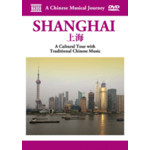
SHANGHAI - A cultural tour with traditional Chinese music
 $35.00
Out of Stock
$35.00
Out of Stock6+ weeks add to cart
VARIOUS COMPOSERS
SHANGHAI - A cultural tour with traditional Chinese music
Various Artists
[ NAXOS MUSICAL JOURNEYS / DVD ]
Release Date: Sunday 30 December 2007
This item is currently out of stock. It may take 6 or more weeks to obtain from when you place your order as this is a specialist product.
 Suitable for General Audiences
Suitable for General Audiences
G - The city of Shanghai, China's most important port, owes some of its prosperity to the so-called unequal treatises forced on China during the 19th century.
Picture format: NTSC 16:9
Sound format: Dolby Digital 2.0 / Dolby Digital 5.1 / DTS 5.1
Region code: 0 (worldwide)
Booklet notes: English, Chinese
Running time: 66 mins
The Places
The city of Shanghai, China's most important port, owes some of its prosperity to the so-called unequal treatises forced on China during the 19th century. The place had its origin as a settlement during the Tang dynasty (618-906 A.D.), but the Treaty of Nanking in 1842 ceded Hong Kong to the British and made possible the development of foreign trade through the five 'treaty ports', of which Shanghai became the most important. The growth of Shanghai into an international trading centre and the concessions made to various foreign countries explain the interesting mixture of architectural styles, continued today with the high-rise buildings of recent years.
The Music
The music chosen for this tour of Shanghai is played on traditional Chinese instruments. Performing the music are the wind and string ensembles known as 'silk and bamboo', from their silk strings and bamboo pipes, and ensembles that also include percussion. Instruments given prominence include the dizi, heard first in Moonlight Autumn Night by the Lake, a transverse bamboo flute, and the yangqin, a Chinese dulcimer whose strings are struck with two bamboo sticks. Traditional Chinese music, like Chinese painting, is largely representational, its character indicated in its titles, although these may sometimes be drawn from opera or from poems.

